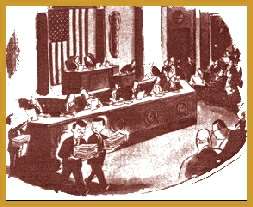15.3 The Federal Budget
The financial problem of a nation includes the acquisition of income, as well as spending it in such a way that the maximum benefits can be secured. According to the Constitution, "no money shall be drawn from the treasury, but in consequence of appropriations made by law." Thus the formal control of the national purse remains in the hands of Congress. The executive has to get appropriations from Congress, through the budget, before taking any action involving the expenditure of money. The federal budget helps the president to rank rival claims on the basis of a system of priorities, and to allocate resources accordingly. It is a device used for planning future governmental programs, a medium for restricting and controlling governmental spending as well as a technique for auditing and appraising past performance.
15.3a Preparing the Budget
The Budget and Accounting Act of 1921 made the
president responsible for the preparation of a budget to be submitted
to Congress. Each department builds up its budget estimates according
to the work program to be carried out by the department. The work
program includes the financial requirements of all activities, as
well as the employees required, the cost of necessary supplies,
equipment, office space and telephones. The estimates should not
exceed a maximum figure established by the president, and should
conform to the general policy directions of the president.
The budget estimates of each department are submitted first to the Office of Management and Budget (OMB) in the Presidentís Executive Office. The estimates are then analyzed by budget examiners for accuracy, consistency of policy, and effective planning of programs. The OMB then conducts hearings to permit the department and agency officials a chance to defend their estimates and clarify their programs and policies. After the hearings, budget examiners prepare their recommendations on the budget for discussion with the Director who decides on the estimates for each department. The estimates are sent for the presidentís approval, after which the final budget is prepared. It is then transmitted to Congress by the president along with his message explaining and justifying the appropriations.
The Presidentís budget is sent to the Appropriations Committee of the House of Representative. The House reviews the estimates through subcommittees which were established under the Budget and Impoundment Control Act of 1974. This Act also established the Congressional Budget Office (CBO). The subcommittees hold hearings and submit its proposed appropriation bills to the House, which transmits its measure to the Senate. There a similar procedure is followed. After congressional action is completed, the appropriation bills are sent to the president.

Exhibit 15.1
Balancing the Budget. Well hereís another two-hundred-million dollar debt theyíre saddling our generation with."
|
Index
15.0 -
Introduction
15.1 The Goals of Economic Policy
15.2 Theories of Economic Policy
15.3 The Federal Budget
15.4 Taxation and Spending
15.5 International Economic Policy
Chapter 16
|